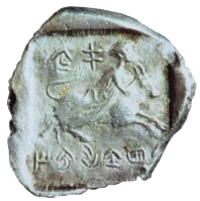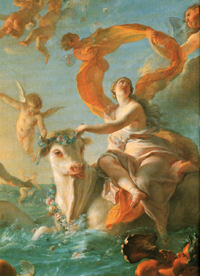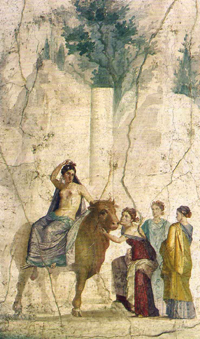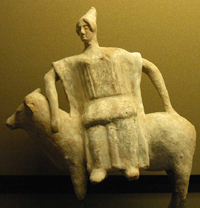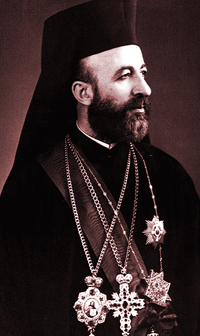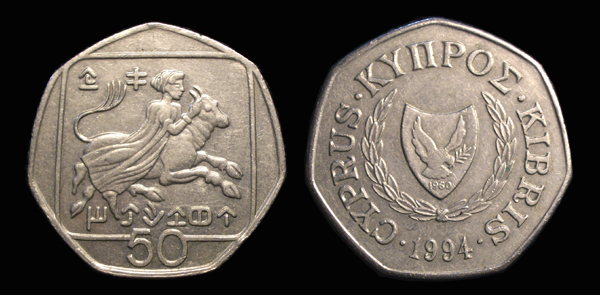
50 CENT COIN - CYPRUS - EUROPA ABDUCTED BY ZEUS
(KM 66)
Date: A.D. 1994
Obverse: Europa being abducted by Zeus in the form of a bull (modeled after ancient coin) - KING TIMOCHARIS (in Cypriot) - 50
Reverse: Coat of arms - CYPRUS (in three languages) 1994
Engraver: Antis Ioannides
Silver Diobol of Timocharis, end of 5th century B.C., Archaeological Museum of Nicosia
Archbishop Makarios: The First President of the Independant Republic of Cyprus |
This coin depicts the abduction of Europa, from Phoenicia to Crete, by Zeus transfigured into a bull with the inscription "King Timocharis" in Cyprosyllabic. King Timocharis was a king in Cyprus, the Kingdom of Marion, around the 4th century BC and this coin is a composition based on one of his coins (picture to the right). This theme is used by Cyprus because they believe that since Cyprus is on the path between Phoenicia and Crete, they must have visited Cyprus on the way. As the myth goes, Europa was a Phoenician Princess, the daughter of King Agenor of Tyre and Telephassa. The god Zeus saw her as she was gathering flowers by the sea and was enamored with her. Overwhelmed by love and passion for Europa, Zeus transformed himself into the form of a magnificent white bull and appeared before her. When Europa saw the great bull she was taken with it's beauty. The bull was uncommonly gentle so she caressed it and spread flowers about his neck and horns. Feeling no fear of the docile beast she dared to climb upon his back. With the Princess on his back, the bull dove into the sea and swam to the island of Crete. Europa's brothers, Cadmus, Cilix, and possibly Phoenix were ordered to look for Europa and instructed not to return until they had found her. It was a hopeless quest, and the brothers became exiles. Cilix ended his search in Asia Minor and established Cilicia. Cadmus consulted the oracle of Delphi and was advised to give up his search and instead to travel until he encountered a cow. He was to follow this cow and to found a city where the cow would lie down; this city became Thebes. Cadmus and his companions went out to fetch water for their new settlement at a fountain where all but Cadmus were slain by a dragon. Cadmus killed the dragon and, at the prompting of the goddess Athena, sowed some of its teeth in the ground. Armed men sprang up from the earth, just as they later would for Jason under similar circumstances. Using the same trick that would eventually serve Jason, Cadmus caused the men to fight amongst themselves until only five were left standing. These five, together with Cadmus, became the original inhabitants of Thebes with Cadmus as their king. He is said to have taught them the alphabet and the art of writing and indeed, the Greek alphabet historically derives from Phoenicia. The many sources differ as to the relationship between Phoenix and Europa, her father, and brothers. Some state that he is Agenors son, others state that he was Agenors brother and father to Europa and her brothers. Whether he is included as a brother of Agenor or as a son, it is clear that his role in mythology was as a King and the eponym of the Phoenicians. Upon their arrival at Crete, Zeus revealed his true identity and ravished Europa (often referred to as the Rape of Europa) and Europa became the first queen of Crete. She bore Zeus three sons Minos, Rhadamanthus, and Sarpedon, who would become the three judges of the Underworld once they died. She eventually married Asterion, the king of Crete, who adopted her three sons and raised them as his own. When he died he gave his throne to Minos who promptly banished his brothers after quarrelling with them. The Greek historian Herodotus presents a variant story that states that Europa was kidnapped by Minoans who were seeking to avenge the kidnapping of a princess from Argos. This may have been an attempt to rationalize the earlier myth or maybe he was stating that the myth was a glorified version of brutal facts — the abduction and rape of a Phoenician aristocrat. He presents the myth as a possible remnant of oral history about the settlement of the island and it is by no means far fetched. Cretans were great sailors and must have come from some mainland area by raft or ship and would have interacted with other kingdoms once settled. They brought with them their cattle and other livestock which were of great value and took a central role in everyday life figuring prominently in their sports, arts and religious imagery. The sacred bull was paramount and In the mythological transformation of history the bull provides the transportation for the founding mother of the Minoan people. In the end, Zeus reproduced the shape of the white bull that was used to seduce Europa, in the stars. Today, we can recognize its shape in the constellation Taurus. Cyprus is the third-largest island in the Mediterranean which lies off the southern coast of Turkey and the western shore of Syria. The island has been inhabited for more than 12,000 years, first by prehistoric hunter-gathers, later by small farming villages until Mycenaean, Greek and Phoenician culture is believed to arrive in the bronze age around 1600 BC. Soon after the island inhabitants came into contact, and began trade with, Egypt. In the 6th century Cyprus was conquered by Amass of Egypt until Cambyses conquered Egypt and it fell into the hands of the Persians. Alexander the great claimed the island for the the Macedonians and then the Ptolemies of Egypt controlled it for a time until Rome annexed it in 58-57 BC. It then became a part of the Byzantine empire in 395 which would rule the island for more than 800 years until King Richard I of England captured the island in 1191 during the Third Crusade. In 1192, the French knight Guy of Lusignan purchased the island, in compensation for the loss of his kingdom, from the Templars. The Republic of Venice took control in 1489 until it was conquered by the Ottoman Turks under the command of Lala Kara Mustafa Pasha in 1570 who sacked its palaces, public buildings and churches and massacred more than 20,000 Nicosian Greeks. Under Ottoman rule the island saw its first major influx of of turkish immigration to the island as those who moved there and stayed were rewarded with money and land. Greek Christians were allowed their own communities but forced to pay steep taxes to Ottoman rulers giving rise to opposition and bloody uprisings. By 1760 the situation in Cyprus was intolerable for both Turk residents and Greek alike. In addition to heavy tax burdens a terrible epidemic of plague, bad crops and earthquakes drove many to leave the island. Cyprus was placed under British control in 1878 as a result of the Cyprus Convention, which granted control of the island to Britain in return for British support of the Ottoman Empire in the Russian-Turkish War. Cyprus was formally annexed by the United Kingdom in 1913 since Turkey had joined the Central Powers. Many Cypriots signed up to fight in the British Army in both World Wars with the promise that when the war finished Cyprus would be united with Greece. The British balked at giving Cyprus its independence spawning resistance and opposition movements until, after seemingly endless posturing and debate, Cyprus was declared an independent state on August 16, 1960 with Archbishop Makarios as it president. The terms of its independences and the two ethnic communities at odds with each other made a peaceful workable government all but impossible. Tensions rose and the populations segregated. Greek citizens looked to unify with Greece, Turkish residence looked to unify with Turkey. Animosity grew and the island fractured culminating in a Greek led coup d'etat and Archbishop Makarios was overthrown in a military coup led by the Cypriot National Guard. Soon after Turkey invaded Cyprus claiming it was asserting its right to protect the Turkish Cypriot minority. Turkey gained control of 30% of northern Cyprus and displaced some 180,000 Greek Cypriots. Talks in Geneva involving Greece, Turkey, the United Kingdom and the two Cypriot factions stalled and Turkish forces continue its military actions on the island. 200,000 Greek Cypriots were displaced from their home land and as reprisal, the entire Turkish Cypriot male population of Tokhni was massacred by Greek Cypriot paramilitaries. A UN-sponsored cease-fire was established on July 22, and Turkish troops were permitted to remain in the north. In December of 1974, Makarios again assumed the presidency. The following year, the island was partitioned into Greek and Turkish territories separated by a UN-occupied buffer zone. The events of the summer of 1974 have dominated Cypriot politics ever since and have been a major point of contention between Greek and Turkish Cypriots, as well as the countries of Greece and Turkey. Turkish Cypriots proclaimed a separate state under Rauf Denktash in the northern part of the island on Nov. 15, 1983, naming it the “Turkish Republic of Northern Cyprus.” The UN Security Council declared this action illegal and called for withdrawal. No country except Turkey has recognized this entity. In May 2004 Cyprus was admitted into the European Union and Turkish Cyprus elected pro-reunification leader Mehmet Ali Talat as their president, ousting longtime leader Rauf Denktash, who staunchly opposed reunification which lends hope to future unification. In 2005, Turkish Cypriots demolished the part of the wall along the boundary that for decades has split its capital and in March 2007, Greek Cypriots demolished the part of the wall on the Greek side. Cyprus is well known as the island of Aphrodite, the goddess of love and beauty, who, according to legend, was born there. Throughout ancient history, Cyprus was a flourishing centre for the cultic worship of Aphrodite. |

